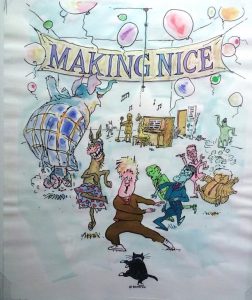This is a project from a field trip to the Society of Illustrator: George Booth – A Cartoon’s Life. The project was designed to evaluate the students’ ability to interpret what was being communicated in the cartoon/illustration. The assignment was based on the following questions:
(1) Pick a comic and ignore the artist’s caption. What does the comic
communicate if we only look at the illustration? How do we know this? What
does the artist place in his drawing to relay his message? How does his
drawing style help further communicate his message?
(2) How do these Illustrations communicate ideas differently from graphic
design? What does Illustration do that graphic design cannot do? What does
graphic design do that illustration and comics cannot do?
(3) Consider who is represented in these illustrations (culturally,
demographically, socio-economically). Who isn’t included? What do these
visual cues tell you about the audience this was meant for? The time period?

Making Nice, full color illustration for the New York Times “week In Review” January 2, 1997 Black ink, marker and wash
This comic is called “Making Nice” and it is a depiction of people having fun at a party. It is evident however that all is not well there seems to be a political issue ensuing, but the subjects chose to ignore whatever is going on as they try to keep up appearances, pretending all is well and not addressing the issue at hand. I know this because there is that huge flamboyantly dressed elephant in the room that cannot be ignore, no matter how hard they dance around him. Then there is this frighten donkey with seemingly happy feet but has a face that looks like a deer in headlights, prancing around in his polka dot draws with his back turn to the situation, the elephant in the room.
This elephant was strategically place there by the artist to convey the message that no matter how much you dance with or around the elephant it will not make him go away. The elephant not only represents a problem that needs to be addressed but also a political party. “Dancing around the elephant in the room” is a term used to express the fact that there is a problem no one wants to address, so they ignore it and play nice. While this is a term not used in its literal sense the artist expressed his message by having the subjects literally dancing around the elephant.
Illustrations communicate ideas through cartoon characters while graphic designs communicate ideas typographically using posters, flyers and logos. An illustration gives a complete story on a particular subject matter and graphic design does not do that. However graphic design gives identity to its subject through branding, by using the elements of design to articulate what they represent and offer which cartoon/comic would not be able to do effectively.
The elephant not only represent a problem that needs to be addressed, but also a political party. The donkey represents the opposing political party. The elephant in the room is affecting everyone across the cultural, demographical and socio-economical spectrum. This is evident in the cartoon because there are men in suit and tie representing the rich and the middle class. The singer and the keyboard player represent the ordinary working people. The cat represents the unemployed who roam the streets looking for fun or trouble. The guy in the pink is probable gay, and the rat (snitch/leaker) is walking towards the door away from the situation he probably has a hand in creating. There is even representation of emotions one man is dancing, but he is green with envy and over in the corner doing the electric slide is a pale green monster representing the suppressed fear in the room. In my opinion.



